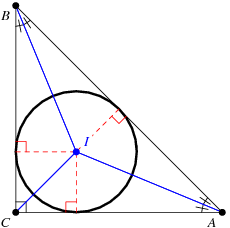A triangle has corners at #(2 , 6 )#, #(3 ,8 )#, and #(4 ,5 )#. What is the radius of the triangle's inscribed circle?
1 Answer
See below.
Explanation:
Solution 1:
By the formula
To find the area, we use Shoelace.
Cross-multiply,
To find the semi-perimeter, we use the distance formula three times (on each side).
So the semiperimeter is:
Thus,
Multiply both sides by
By rationalizing (multiply both sides by
We get that
Solution 2:
We recognize that these points form an isoceles right triangle.

Let's name the point where the perpendicular from
We first note that:
The angle bisector through C (which goes through the center of the circle) is also the median of the hypotenuse. An by the Two-Tangent theorem,
Designating the radius as
but
So,

